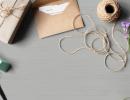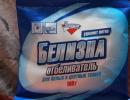Crafted spider on a web made of natural material. Spider made from cones Crafts made from natural materials spider on a cobweb
How to make a children's craft "Spider" from natural material with your own hands. Step-by-step instructions with photos.
Spider - children's craft made from natural material
Autumn provides a lot of varied natural materials, which are indispensable in children's creativity. In this article I will tell you how to make a children's craft "Spider" from natural material.
The principle of making this craft is simple: the legs are made of fluffy wire, and the body of the spider is made of chestnuts, acorns, nut shells, pebbles, cones, etc. You can also use not natural, but waste material. For example, plastic bottle caps.
Spider - craft made from nut shells
Materials and tools
To make a “Spider” craft from natural material (walnut shells) you will need:
- half a walnut shell
- plastic (or cardboard) eyes
- (black or multi-colored)
- scissors
- glue or double-sided adhesive tape (scotch tape)
- thread
How to make a spider from natural material. Instructions

Spider - craft made from chestnuts
The “Spider” craft made from chestnut is done in a similar way. At the time of making the craft, we did not have enough black fluffy wire for it, so the legs turned out to be a bit short, and the spider itself looked more like an octopus. But the idea of creating an octopus from chestnut and fluffy wire can be used when making three-dimensional crafts on the theme “Sea”. In this case, it is better to take a fluffy wire that is not black, but, for example, purple.

Spider - craft made from acorns or acorn caps
A funny spider can come from an acorn or its cap.

Spider - craft made from stones
Since spiders in nature come in a wide variety of colors and patterns, the body of the spider can be painted in whole or in part with acrylic paints. Draw circles, stripes on it, or show your imagination and come up with other patterns.


Or experiment with the color of the fluffy wire for the paws.


I suggest looking at articles about other crafts with spiders (from rubber bands, paper, etc.) in the section or others (for example, and, etc.).
© Yulia Valerievna Sherstyuk, https://site
All the best! If the article was useful to you, please help the development of the site by sharing a link to it on social networks.
Posting site materials (images and text) on other resources without the written permission of the author is prohibited and punishable by law.
DIY crafts with children are scary and give you goosebumps! The spiders we created from ordinary cones are so realistic that it is better for impressionable people not to touch their fluffy legs and hard back. However, as soon as you spend a little time in the company of these arthropod characters, not a trace of arachnophobia remains, and the spiderlings will take pride of place as your favorite toys. Today we will talk about do-it-yourself crafts from pine cones for a kindergarten or a home collection of toys. Don't be afraid to try your hand - we will be with you!
What do we need
To make a spider for kindergarten, use the following tools and materials:
- round bump
- Piece volumetric eyes - different sizes
- Fluffy brown chenille wires - four pieces
- Scissors
- Glue gun
What are we doing
The cone consists of many processes, arranged in circles– and we will try to use it. Using the tip of scissors, we push fluffy wires between the plates - one side will become the left leg, and the other - the right. Positioning the limbs on equal distance, we equip the character with a full set of eight legs.
 Our next stage– exclusively for adults (kids are given the honorable and completely harmless role of spectators). We arm ourselves with a glue gun, apply a drop of molten plastic to the workpiece and immediately press a decorative eye on top.
Our next stage– exclusively for adults (kids are given the honorable and completely harmless role of spectators). We arm ourselves with a glue gun, apply a drop of molten plastic to the workpiece and immediately press a decorative eye on top.
For our DIY craft with children, we chose the number of eyes, which, according to all canons, brings good luck - seven. We think nature will forgive us such a small deviation from realism. By the way, it is the combination of large and small buttons that looks as effectively as possible.
That's all! The work was over before it even began!
 Did you like creating? Visit the section of our website dedicated to handicrafts - a real ocean of fun and original ideas awaits you.
Did you like creating? Visit the section of our website dedicated to handicrafts - a real ocean of fun and original ideas awaits you.
Autumn is a creative time. Autumn gives us a lot of materials for crafts. Children find it very interesting when funny little animals or people appear from an ordinary cone, nut, acorn, or leaf.
Autumn crafts from natural materials. Chestnut spider on a web.
To make such a spider from natural materials we will need 2 chestnuts, black plasticine, some white plasticine, 4 black wires (the kind used for twisting wires)
We bend the wires - legs in half and at the knees. 
We attach the legs to the abdomen with pastille. 
We attach the head to the body with plasticine. Attach the eyes. The chestnut spider is ready. 
To make a web for a spider we will need a glue gun, 4 sticks, threads, glue, leaves for decoration. 
Place one stick on top of the other perpendicularly. We break the remaining 2 sticks in half and place them first. This is necessary so that there is no thickening in the center.
Fill the center with silicone from a glue gun and let it cool. 
Now we tie a thread near the center and begin to weave the web in a circle. After the first circle, we go up a couple of turns and weave the next circle, etc. It is better to lubricate the sticks with PVA glue. I didn’t do this, but I should have done so - the threads were slipping here and there. 
Glue the spider to the center of the web. 
According to legend, spiders cannot be kicked out of the house; they protect the home from negativity and uninvited energetic guests.
Make this cute amulet with your own hands - a chestnut spider and a dragonfly made from natural material will do the job perfectly! A decorative web made of threads will never be a reason to think of you as a bad housewife; rather, on the contrary, all guests will admire the original decor! Every novice needlewoman can cope with the task.
Preparation of materials and tools
To create the “Chestnut Spider on a Web” craft, as in the photo, you will need the following materials and tools:
- two chestnuts (large and small);
- viburnum fruits;
- two acorn caps;
- three cones with thuja branches;
- five “helicopter” petals;
- fruits of the Saphora tree;
- eight wooden skewers;
- thread with sequins (or any other thread);
- wine cork;
- two fleecy sticks with a wire base, dark brown and light brown;
- a piece of black plasticine;
- scissors;
- glue gun

If you don't have some decorating materials, that's okay, use something else or reduce the number of decorations.
Step-by-step master class on creating decor
First you need to prepare wooden skewers to create the base of the craft - the web. Leave the length of the skewers 10 cm (more or less, depending on the desired size of the finished product), sharpen the blunt edges of the skewers with a knife.

Tie a thread to the finished “skeleton” for the web, closer to the center, to one of the skewers. Secure the knot with a glue gun. Then, at the same level, wrap all the skewers one by one, fixing the intersection of the thread on the stick with glue so that the thread holds its shape better and does not slip. 
After the first level of web, you need to wrap the thread near the initial knot, fix it and make two turns along the same skewer, lifting the thread up to continue the next row of web. Thus, go around in a circle and drop all the skewers to the edges, do not forget to fix the intersections with glue, especially the last knot. 
The web of threads is ready. 
Then start making a hospitable host for the web - a spider from chestnut and fuzzy sticks. For the insect cap you will need: a helicopter petal and an acorn cap. 
Glue a small chestnut to the edge of the larger chestnut, closer to the top. This will be the body with the head of the spider. Then use fuzzy stick scissors to cut 6 legs of 3-4 cm each and bend them slightly in the middle. Glue three legs to the sides of the body (large chestnut).
Cut off the edge of the “vertical” - this will be the visor of the cap and glue it to the acorn cap, and then to the spider’s head. Roll out plasticine and stick on two black eyes. Cut a piece of light brown stick and attach it around the spider's neck. The spider is ready.

Now it’s time to make your own dragonfly from natural material: the body is from a piece of fuzzy stick, the wings are from “verticals”, the head is from an acorn cap, the eyes are from plasticine. 
Start making a dragonfly from the body. To do this, bend the wire almost in half (make one edge a little longer) and twist it slightly (not tightly), leaving a small loop at the base and a thinner end. Glue a head - an acorn cap - to the loop and glue two round, flat eyes made of black plasticine. Glue two “helicopters” on both sides along the edges of the loop - these will be the wings of a dragonfly.

The last guest on the web will be the caterpillar. To make it, you will need the fruits of the Saphora tree (to make the caterpillar longer, they can be glued together). Make the eyes and glue them on from plasticine. 
Place the chestnut spider and other inhabitants and glue it to a decorative web of thread.
To decorate the composition, glue a composition of thuja branches and three cones into the center. 
Add a few brushes of viburnum or rowan along the edges “for a little sparkle”. The craft is ready.

You can make a loop for the craft “Spider from chestnuts on a web” and hang it as a talisman. Let the spider protect your home, which will always be full of goodness and long-awaited guests.
Other ideas of what are waiting for you in our other publication. Such creativity can safely be attributed to, because it requires virtually no costs.
Visit us more often and subscribe to the “Women’s Hobbies” website groups on social networks to be the first to know about the release of new master classes.
The craft of a spider on a web made of natural material is simple in appearance, but it looks original and interesting. Yes, and it’s very easy to do.
What will you need for the craft?
- Thin branches;
- Dry leaves;
- For the spider to choose from: acorn, cone, chestnut;
- Plasticine;
- Scotch tape, white threads (thicker is better);
- Moving eyes, but they can be made from white and black plasticine.

How to make a spider craft on a web?
First you need to decide what or what your spider will be made of. There are these options:
You will need plasticine, a pine cone, thin twigs. The branches should not be too dry so that they do not break off completely when bent.

Prepare 6 identical pieces broken off from a branch. Glue brown plasticine onto the cone between the scales.

Place twigs in plasticine to form spider legs. To do this, the branches need to be slightly broken and bent. For reliability, the fracture site can be secured with plasticine.

Next, all that remains is to glue the eyes and the pine cone spider is ready. All my eyes move, but they can easily be made from plasticine. Roll out two balls from white and the same number of balls, but smaller ones, from black plasticine. Glue it on the pine cone and you will get a very funny bug-eyed spider.

Prepare brown plasticine, twigs, chestnut and acorn cap. And also purchased eyes or plasticine ones.

Glue a small layer of plasticine onto the bottom of the chestnut, which will hold the spider's legs and branches. They also need to be slightly broken or bent, and the bend points secured with plasticine (optional).

All that remains is to glue the eyes, the acorn cap and the funny chestnut spider is ready.

Another simple version of a spider made from natural material. It is made in exactly the same way as from chestnut. You will need branches, plasticine, an acorn, and eyes.

You need to glue plasticine to one part of the acorn, and stick 6 bent branches into it. The spider's appearance will be completed by its eyes and nose. I subsequently added plasticine noses to all the spiders.

These are the kinds of spiders you can make from natural materials. For the craft, just one of your choice is enough.

Making a web for a spider from natural materials
Take 3-4 branches, relatively the same size, connect them crosswise. Secure the intersection with tape. If the branches are very thin, plasticine is enough; thicker branches need to be carefully secured in several layers with tape, ensuring that they practically do not move. Otherwise the threads will sag.
Then you can immediately wind the threads, but it is better to first glue the plasticine to certain areas. The photo shows their location. There are many advantages of this action: the plasticine will hold the thread on the branch, hide it, and leaves can later be glued to it.

Wind the threads. I have them thin, it’s better to take a thicker one. You must first wind one tier, from branch to branch, and several times around the place marked with plasticine. Then the second and third. If desired, you can make more of them.

Everything is ready, glue a large maple leaf onto the plasticine in the center - this will be the spider’s nest. And on the sides there are any small leaves - probably the wind blew them into the web. But more for beauty.

The web has been made, now it’s time to place it in the nest of its owner. Here is a chestnut spider on the web.


And now the home and hunting place of the cone spider.


The acorn spider has settled down quite well.


And now the spiders are all together, although in real life the spectacle would not be for the faint of heart.

This is what a spider on a web made from natural material could look like, simple and as natural as possible.






